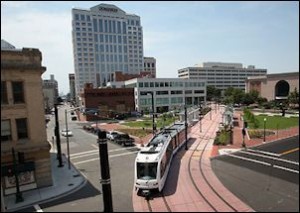by James A. Bacon
Randal O’Toole, the Cato Institute’s transportation scholar, has penned a devastating take-down of Norfolk’s light rail system, the Tide. The rail line, which opened in 2011 60% over budget and 16 months late, ran operating losses of $12.5 million in 2012, about double projections. Farebox revenues covered about 5% of operating costs. Hoped-for redevelopment around the Tide’s eleven stations has yet to materialize. (The post is supposed to appear on O’Toole’s blog, The Antiplanner, but I could not find it there. I am relying upon an email version.)
Now, says O’Toole, the editorial writers at the Virginian-Pilot want to compound the folly by slashing fares from $1.50 per trip (before discounts), among the lowest in the nation, to $.50 in a desperate bid to jolt ridership and stimulate economic development. The problem with that idea, he says, is that it cannot generate sufficient ridership to encourage developers to build around the train stops. The idea would expand the operating deficit while doing nothing to build the property tax base.
Ironically, light rail, much beloved by environmentalists for taking CO2-emitting cars off the road, is more energy-intensive at low levels of ridership than automobiles. Writes O’Toole: “Norfolk’s rail line uses far more energy than cars: 5,400 BTUs per passenger mile in 2012 compared with an average of less than 3,400 for cars and 4,100 for light trucks (and 3,7000 for Hampton Roads buses).”
O’Toole continues:
Rail transit is supposed to be about bringing large numbers of people into major job centers. But there are no major job centers in the region, or at least none served by the Tide rail line: Norfolk has only about 24,000 downtown jobs, less than 3 percent of the metropolitan area. Transit subsidies are also supposed to help low-income people who don’t have cars reach jobs, but the 2012 American Community Survey found that only 2.6 percent of workers in the Norfolk-Virginia Beach urban area lack cars, and half of them travel to work by car, while only 32 percent ride transit.
In fairness to the Tide, the rail line’s financial performance has improved since 2012. A mid-2014 review indicated that farebox recovery had increased to 17.7% and the operating cost had declined to $3.4 million (or $6.8 million annualized).
Still, even the updated numbers call into question the wisdom of extending the line to the Virginia Beach resort district, a project that could cost more than $1 billion. Does Virginia Beach really want to spend hundreds of millions of its own money (the state and feds would pick up much of the tab) for the privilege of creating a permanent subsidy and tax drain at a time when Americans are driving less and congestion is easing?
Bacon’s bottom line: Mass transit is a great idea… when it works. But the fact that heavy rail has done wonders in New York City and the core Washington metropolitan area does not mean that light rail will have a similarly transformative effect in a sprawling, low-density metro like Norfolk-Virginia Beach. You can’t force-feed mass transit. Commuter rail requires high-density, mixed-use pedestrian friendly development around rail stations. That land use pattern does not exist in Norfolk/Virginia Beach right now. It will take appropriate zoning, years of re-development and public investment in creating walkable streets before there is any chance of generating sufficient ridership to justify the investment.
There is a logical progression for mass transit: Serve a transportation corridor with scheduled bus service and support it with higher-density, mixed-use rezoning. If and when sufficient redevelopment occurs along the corridor to support it, upgrade the service to Bus Rapid Transit. If and when sufficient redevelopment occurs to support another phase transition, upgrade the route to rail. That process could well take decades, too long a time to satisfy impatient environmentalists who want to save the world now. But it would be fiscally sustainable in an era in which Virginia local governments are increasingly hard-pressed to meet their obligations.
Meanwhile, the Uber-Lyft revolution continues to roil the transportation industry. Using smart phones to connect drivers with riders and writing algorithms that optimize the distribution of fleet vehicles serving different price points and demographics (Cadillacs for rich riders, vans for poor riders) could render much of our transportation infrastructure obsolete. I’m still waiting for a politician who says it’s time to prioritize ride-sharing over mega-road and transit projects. Surely, there’s someone out there!



